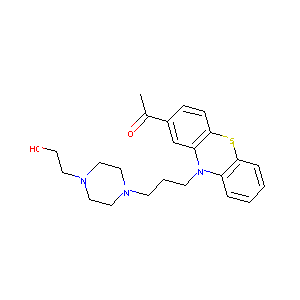Details of the Drug
General Information of Drug (ID: DMZV2PJ)
| Drug Name |
Acetophenazine
|
|||||||||||||||||||
|---|---|---|---|---|---|---|---|---|---|---|---|---|---|---|---|---|---|---|---|---|
| Synonyms |
Acephenazinum; Acetophenazina; Acetophenazinum; Tindal; Acetophenazine [INN]; Acetophenazina [INN-Spanish]; Acetophenazinum [INN-Latin]; Ketone, 10-(3-(4-(2-hydroxyethyl-1-piperazinyl)propyl)phenothiazin-2-yl methyl; 1-(10-{3-[4-(2-hydroxyethyl)piperazin-1-yl]propyl}-10H-phenothiazin-2-yl)ethanone; 1-[10-[3-[4-(2-hydroxyethyl)piperazin-1-yl]propyl]phenothiazin-2-yl]ethanone; 10-(3-(4-(2-Hydroxyethyl)-1-piperazinyl)propyl)phenothiazin-2-yl methyl ketone; 2-acetyl-10-[3-[4-(b-hydroxyethyl)piperazinyl]propyl]phenothiazine
|
|||||||||||||||||||
| Indication |
|
|||||||||||||||||||
| Therapeutic Class |
Antipsychotic Agents
|
|||||||||||||||||||
| Drug Type |
Small molecular drug
|
|||||||||||||||||||
| Structure |
 |
|||||||||||||||||||
| 3D MOL | 2D MOL | |||||||||||||||||||
| #Ro5 Violations (Lipinski): 0 | Molecular Weight (mw) | 411.6 | ||||||||||||||||||
| Topological Polar Surface Area (xlogp) | 2.6 | |||||||||||||||||||
| Rotatable Bond Count (rotbonds) | 7 | |||||||||||||||||||
| Hydrogen Bond Donor Count (hbonddonor) | 1 | |||||||||||||||||||
| Hydrogen Bond Acceptor Count (hbondacc) | 6 | |||||||||||||||||||
| Chemical Identifiers |
|
|||||||||||||||||||
| Cross-matching ID | ||||||||||||||||||||
Molecular Interaction Atlas of This Drug
 Drug Therapeutic Target (DTT) |
|
||||||||||||||||||||||||||
|---|---|---|---|---|---|---|---|---|---|---|---|---|---|---|---|---|---|---|---|---|---|---|---|---|---|---|---|
| Molecular Interaction Atlas (MIA) | |||||||||||||||||||||||||||
Molecular Expression Atlas of This Drug
| The Studied Disease | Bipolar disorder | |||||||||||||||||||||||
|---|---|---|---|---|---|---|---|---|---|---|---|---|---|---|---|---|---|---|---|---|---|---|---|---|
| ICD Disease Classification | 6A60 | |||||||||||||||||||||||
|
||||||||||||||||||||||||
| Molecular Expression Atlas (MEA) | ||||||||||||||||||||||||
References
